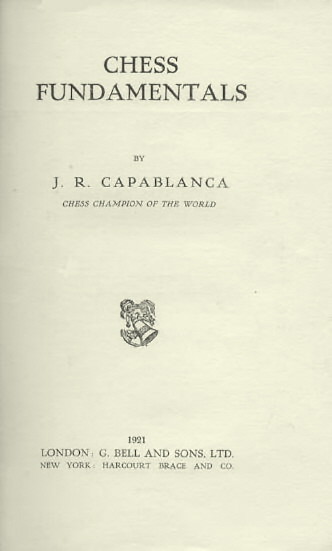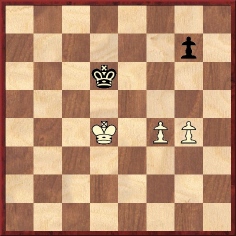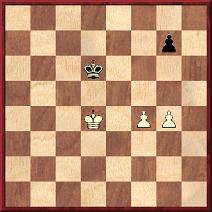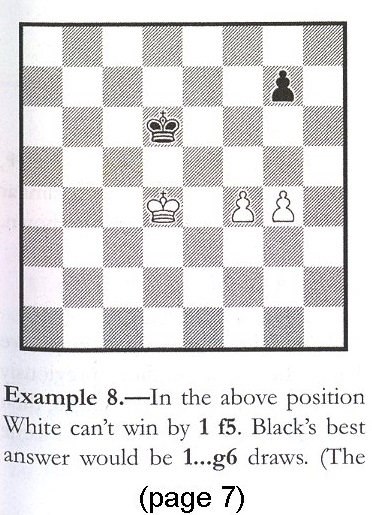
Edward Winter
(1993, with additions)

In Chess Fundamentals Capablanca published the following as ‘Example 8’:

Page 64 of Comprehensive Chess Endings, volume 4, by Y. Averbakh and I. Maizelis (Oxford, 1987) comments on the position as follows:
‘Here the only move not to win is 1 g5? in view of 1...g6. Curiously, in the 1st edition of his Chess Fundamentals, Capablanca asserted (he later corrected this) that 1 f5 also did not win in view of 1...g6 (he left the analysis of the variation to the reader). Capablanca gave the solution 1 Ke4 Ke6 2 f5+ Kf6 3 Kf4 etc. But it is precisely by 1 f5! that White wins more quickly.’
Critical analysis of this position appeared on page 268 of the November 1949 Magyar Sakkvilág, where Dr Jenő Bán claimed to correct Capablanca by demonstrating a win by 1 f5 g6 2 fxg6 Ke6 3 g5 (Not 3 Ke4 Kf6 4 g7 Kxg7 5 Kf5 Kf7, with a draw) 3...Ke7 4 Ke5 Kf8 5 Kf6 Kg8 6 g7 Kh7 7 g8(Q)+ Kxg8 8 Kg6 and wins. These moves were repeated by Fred Reinfeld on page 279 of The Joys of Chess (New York, 1961), in a chapter entitled ‘Boners of the Masters’. The ending was also discussed in Chess Life & Review in June 1971 (page 306), December 1971 (page 704) and November 1972 (page 549). The last of these was a contribution from Paul Keres:
‘Furthermore, I got interested in the position from Capablanca’s Chess Fundamentals, given in Dec./71, page 704. I have not got the English edition of the book, but in the German translation (1927 and 1934) the statement is that 1 P-B5 does not win because of 1...P-N3. The Russian translation of the book, on the contrary, states that 1 P-B5 also wins, Black’s best counterchance being 1...P-Kt3. My impression is that Capablanca originally made the mistake, thinking the position was a draw, but later, noticing his error, did make a correction. Of course that is only my impression – I have no facts to prove it.’
So did Capablanca commit a ‘boner’ by claiming that 1 f5 would not win and, if so, did he correct it? All editions of Chess Fundamentals published in the United Kingdom (including the 1921 original) seem to state: ‘In the above position White can win by 1 P-B5 [our italics]. Black’s best answer would be P-Kt3.’ The Cuban adds that White ‘cannot win by 1 P-Kt5, because P-Kt3 draws’ and later writes that ‘White can win, however, by playing 1 K-K4’. This is followed by a number of variations.

UK edition, 1921, page 12
G. Bell and Sons, Ltd. were the UK publishers, but the US edition was published by Harcourt, Brace and Company. The original 1921 US edition reads:
‘In the above position White can win by 1 P-B5. Black’s best answer would be P-Kt3 draws. (The student should work this out.) He cannot win by 1 P-Kt5, because P-Kt3 draws.’

US edition, 1921, page 14
The first two sentences obviously contradict each other, and in the second sentence the word ‘draws’, which is absent from the UK edition, is syntactically incorrect. Did the US typesetter accidentally add the word, perhaps led astray by the similarity to the way the final sentence ends? (Homoeoteleuton.)
To eradicate the contradiction, one of the first two sentences in the US version needed to be changed. Remarkably, the solution adopted – in the mid-1930s US edition, which was published with a new Preface by Capablanca dated 1 September 1934 – was to put: ‘In the above position White can’t win by 1 P-B5. Black’s best answer would be P-Kt3 draws.’

US edition, mid-1930s, page 14
To summarize, although it was suggested by Averbakh and Maizelis that Capablanca a) wrongly wrote that White cannot win with 1 f5 and b) later corrected the text to ‘can win’, in reality the change (made in the mid-1930s US edition) went in the opposite direction: ‘can’ was altered to ‘can’t’. Why and by whom?
Further complications arise concerning the German edition (published in 1927 by Walter de Gruyter & Co. under the title Grundzüge der Schachstrategie), from which Dr Bán was working.
For some reason it stated:
‘In der Stellung (Beispiel 8) kann Weiß nicht durch 1 f5 gewinnen; die richtige Erwiderung wäre 1...g6 (der Leser möge dies selbst durchdenken). Weiß kann auch nicht gewinnen mit 1 g5, weil Schwarz g6 antwortet.’

German edition, 1927, page 8
The words nicht and auch have no equivalent in the original English-language editions. More confusion occurred when the 1979 reprint of the German translation amended the position to justify the nicht: White’s king was put on e3 and Black’s on e7.
Do readers know of any other pre-1934 editions, in any language, which state, ‘White can’t win by 1 f5’?
(2011)
‘Capablanca’s Boner’ is the gleeful caption to a diagram on page 26 of Great Chess Books of the Twentieth Century in English by Alex Dunne (Jefferson, 2005). It concerns this well-known position discussed by the Cuban in Chess Fundamentals:

However, Mr Dunne shows himself oblivious of the complexities set out on pages 319-320 of Kings, Commoners and Knaves. In the same section of his book (page 25) he also goes awry on the elementary matter of the proportion of Capablanca’s losses given in Chess Fundamentals, and on page 27 he misspells (i.e. miscopies from pages 332-333 of A Chess Omnibus) the name of the person spuriously indicated as the author of the first pirated Coles edition of Chess Fundamentals. This sequence of ‘Dunne’s Boners’ comes from the single Chess Fundamentals section in Great Chess Books, and the rest is no better. The most forbearing observation about Mr Dunne’s work is that The Literature of Chess by John Graham, a similar volume published by the same company (McFarland) in 1984, was even worse, but that is faint praise indeed.
(3830)
See too C.N.s 8422 and 8426, as well as Capablanca Book Destroyed.
Addition on 23 May 2024:
The incorrectly printed text continues to appear in some editions of Chess Fundamentals, such as the ‘2018 SDE Publishing’ one (ISBN: 978-0-9993194-5-1) pointed out to us by Geoff Chandler (Edinburgh):

To the Chess Notes main page.
To the Archives for other feature articles.
Copyright: Edward Winter. All rights reserved.